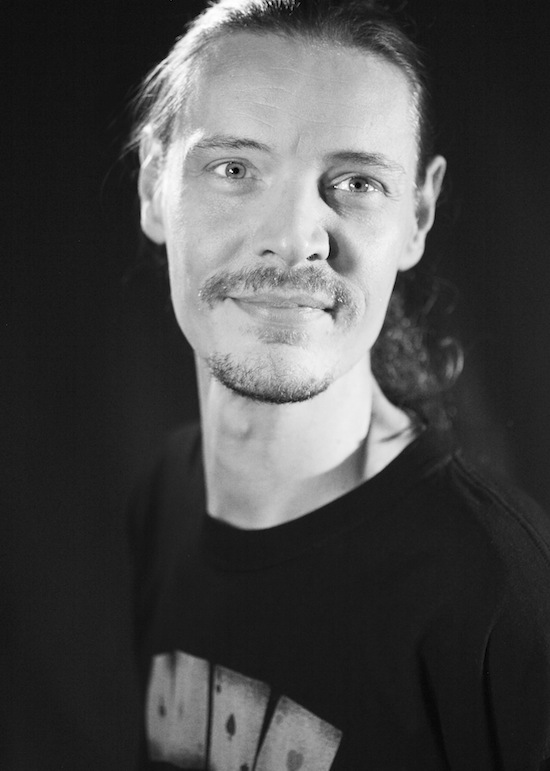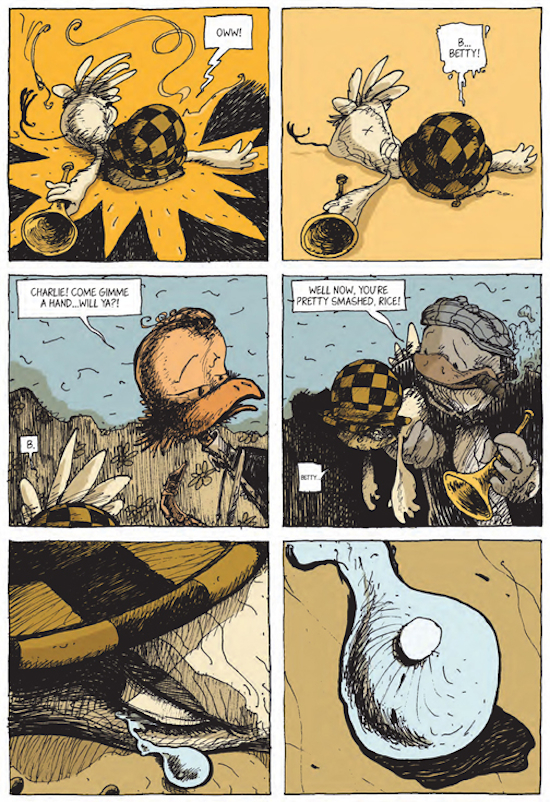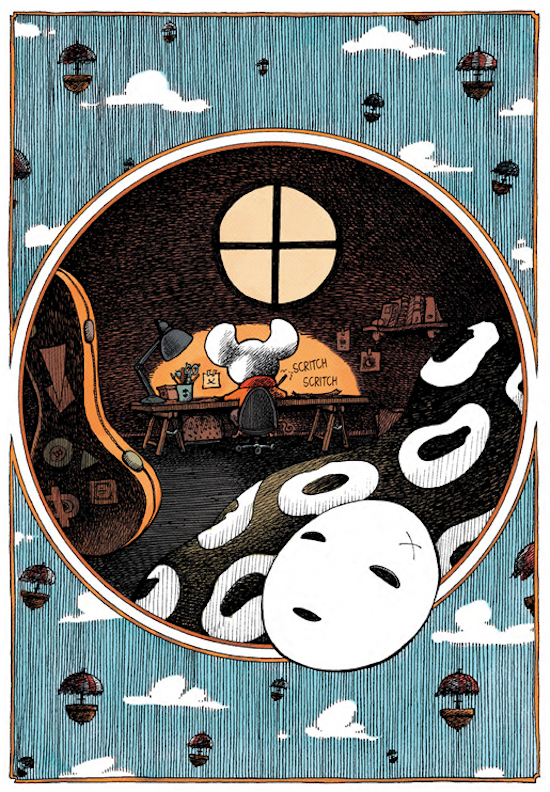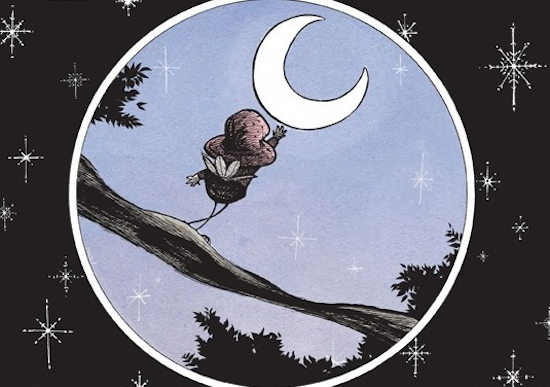I’ve raved about Renaud Dillies and Régis Hautière’s Abelard in the last couple of Quietus Comics Columns. The best thing I’ve read in ages. And on 1 November, NBM released an English edition of Dillies’ first book, Betty Blues, winner of Best Debut at the Angoulême Comics Festival in 2004. The story of Rice, a trumpet playing duck, who loses his love, Betty, to money and champagne. Railing against ‘this life of monomaniacal has-beens who slave away every night…shouting to people that you exist…and believing you’re not alone’, Rice tosses his instrument into the river and sets off, knowing not where, while Betty grows uncomfortable amidst the glitz of her new life. The story follows the three of them – Rice, Betty, and the trumpet – as Rice rediscovers how much his vitality is linked to music and Betty finds emptiness at the bottom of her champagne glass. Completed in two months, Dillies speaks below about the pressing need that drove him to pen this tale.
Abelard and Bubbles & Gondola, quite rightly, bear the description ‘A Magical Graphic Novel’ on their covers. Dillies’ mixture of wonder, sadness, and humour beautifully capture the struggle to keep your dreams alive against the despair of the world, and the enchantment life bestows on such determination. Abelard, written by Régis Hautière specifically for Dillies to draw, tells of a young sparrow with a magic hat who leaves his marsh in order to procure a ‘bouquet of stars’ to win the fair Eppily’s heart. During his adventures he befriends Gaston, a curmudgeonly bear whose motto is ‘Life ain’t for the faint-hearted’. The ending, bursting with heartbreak and tenderness, will stay with you for a long, long time. Bubbles & Gondola muses over Dillies’ own struggles with writing in the form of Charlie the mouse. We follow this ‘quirky’ little character through intense bouts of solitude and into the fantastic carnival that sweeps his town, all the while being privy to the many ways in which, spurred on by the slightest of fancies, his imagination takes flight.
Born in Lille, Dillies studied at the prestigious Saint Luc art school and the Academy Of Fine Arts in Tournai, Belgium before apprenticing for Spirou magazine. After Betty Blue came Sumato, Mister Plumb (another collaboration with Hautière), and the wonderfully named Mélodie du Crépuscule. These, along with Le Jardin D’Hiver (written by Dillies, illustrated by Grazia La Padula), all await English translation. Publisher Terry Nantier offers, ‘I chose to publish him because of the lyricism of both his art and stories. The roots in classic comics like Herriman is also attractive but he brings his own modern twist to that.’ We’d like to thank Terry for translating this interview for us.

(photo Dargaud/Rita Scaglia)
Your books are described as ‘magical graphic novels’, and I certainly think this is true. How do you define magic and what does it mean to you?
Renaud Dillies: Maybe the magical side comes from the way I approach my stories… and I’m well aware that in my universe, dreams hold a major place. You can frequently find elements dear to my heart like the stars, the moon, music…and a certain poetry. Things which are in the end, I believe, universal.
What was the inspiration for the book Betty Blues?
RD: Betty Blues comes from personal experience, quite simply. In a way, baggage from the past that had to be put down. I put in my deepest feelings and impressions in the guise of a little trumpet-player duck, it’s so much easier that way…
I did the story on a whim, without even asking myself whether this would be of interest to any publisher. What mattered was to tell this story which I couldn’t hold anymore and which I gave birth to with a certain interior violence, to be frank. I used only one pen to give it an even more brutal side and I drew everything holding the pen wrong side around, avoiding any pleasantries. And so, if it’s sincere…
I assume ‘Betty Blues’ is a reference to the English title of 37°2 le matin (Betty Blue), correct me if I’m wrong, and you have such a strong visual sense, what films do you enjoy?
RD: Honestly, I wasn’t looking to make an allusion to this film, that was a coincidence. In Betty Blues I voluntarily cite Fellini’s La Strada, a movie where the story, the characters, the pictures as well as the music really touched me a lot. It’s also the story of a trumpet-player. In cinema, I could point to – amongst many – very poetic movies by such directors like Charlie Chaplin or Jacques Tati, more recently Terry Gilliam or Emil Kusturica… much tenderness, craziness, and dreams!

What comics did you read growing up? Who are your favourite comics artists?
RD: As far back as I can remember, I learned to read from my father’s Tintin magazines. Then what my brothers and sisters would read of the magazines of the day like Tintin, Spirou, A Suivre, Pilote…
My best discoveries are with the masters, Winsor McCay, George Herriman, and Calvo. Those continue to make me dream. I also admire the work of Alan Moore, awesome! And I’ll always be impressed by R. Crumb. With those guys, in comics, everything is possible to tell. It’s fabulous!
You’ve created such a wonderful world with its own style. Do you see similiarities to any of your favourite works in this way? What made you choose to work with anthropomorphic animals?
RD: You’re not born out of nothing, of course. My work is a cloth embroidered with all my encounters BD [‘bande dessinée’, what the French call comics] as well as literary, but also in painting, sculpture, music…poetry being for me the highest form.
The choice of animal characters was obvious for me. To tell of the vicissitudes of the life of a mouse gives it a lighter side, easier to swallow. After all, it’s only a mouse. With that, under the guise of a childlike form, I can bring forth all my sensations freely. But if I had to answer even further, a question is burning my lips – Is man not an animal?
How close is the character of Charlie in Bubbles & Gondola to yourself?
RD: Bubbles & Gondola is probably, of all my books, the most intimate one. In it, for me, everything is true. To the point where I’m always that type of mouse who has trouble finding the difference between reality and dreams. I know I’m not a mouse and that my name isn’t Charlie, but when on page 76 Charlie breaks his favorite coffee cup, it’s a whole boat going down within him. Indeed, like Charlie, I’m incapable of believing that the reality of the broken cup is more important than a magnificent three-masted ship within which he saw himself making many trips around the world.
Writing, for Charlie as for me, is to know to bring down your garbage. A totally banal daily act, without event, unless, like Charlie, you dream of the world…

Your collaboration with Régis Hautière on Abelard…
RD: Régis Hautière contacted me by phone telling me he was going to send a synopsis for a story which, he told me, only I could possibly do. And that if I didn’t like this story that he would forget about it, that he couldn’t imagine anyone else doing it. After that call, I rushed with some trepidation, but a lot of curiosity, to read it. And right away I fell under its charm. The strength of Régis is that he was able to write a custom story for me. Just like slippers, I only had to slip them on. Such generosity in his writing literally blew me away.
Music plays a part in each of your stories. Do you play music yourself?
RD: Music is the soundtrack of my work. When I draw, I put together a playlist fitting the various atmospheres I need to approach. And yes, I’m also a musician. It counterbalances the solitary side of an author. Sharing music with others does me a world of good.
I love a lot of different styles of music. It’s very important for me to not get stuck in one genre and I’m always avid for discovery. The most important albums and artists for me are Jeff Buckley, especially Live at Sin-é. Sigur Rós with their incredible ambience. Also more energetic records like Gogol Bordello’s Gypsy Punks. This week I was turned on to Dark Dark Dark’s Wild Go. I like it a lot and I didn’t know it…I’d better stop there, the list would be too long.
Django Reinhardt’s name has popped up a couple of times in your work.
RD: Ah, Django! A genius musician but also an incredible composer. His swing is unique and he really created a style. With him, as soon as I hear one of his tracks, he literally hypnotizes me! Truly, why not believe in extra-terrestrials? Here’s a famous one!
And to say what I feel when I listen to him, words fail me. It’s so free, full of life, sensitive and something which harks of the feather as well as of lead. He always takes you on a voyage from the first note to the last.
And my standard last question – Say you had stolen a space shuttle and were flying it directly into the sun, for whatever reason you had of your own. What would you want to be listening to?
RD: Absolutely and without a doubt ‘An Ending (Ascent)’ from the album Apollo by the great Brian Eno!
Betty Blues published 1st November by NBM


